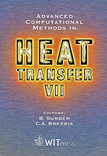3D Unstructured Finite Volume Technique For Modelling Earth Air Heat Exchangers
Price
Free (open access)
Transaction
Volume
35
Pages
10
Published
2002
Size
572 kb
Paper DOI
10.2495/HT020461
Copyright
WIT Press
Author(s)
M De Paepe
Abstract
Ground-coupled heat exchangers can be used to reduce energy consumption in building ventilation systems. The idea is to preheat air in winter and precool air in summer using the thermal capacity of the soil. To do this concrete or plastic tubes are put under ground. Through these tubes the ventilation air is drawn. Due to the temperature difference between ground and air, the ventilation air is cooled or heated. The scope of this paper is to describe and develop a three-dimensional unstructured finite volume model for the calculation of the ground-coupled heat exchanger. The model solves the conduction through the soil (including radiation and convection on the top layer) and the convective heat transfer with the air flowing through the pipe, using the unstructured finite volume solver of FLUENT. Time stepping is introduced to take the seasonal variations into account. The model is validated with measurements done on an existing ground-coupled heat exchanger and then used to study the performance of the ground-coupled air heat exchanger in the Belgian climate situation. Calculations are made with the Test Reference Year (TRY) data of Uccle (Belgium). It is shown that in summer the air can be cooled with about 9 K at sufficient depth (3 m) and tubes of about 50 m. In winter heating of 7 K can be realised. It is also shown that a good control strategy is important.
Keywords





